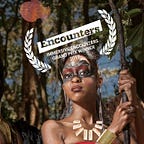 There stands a massive library in my father’s house, and as a child I used to rummage through his books. My hands would often settle on this photography book with a picture of a tall-looking, chocolate-colored man with ornaments in his turban and his lips painted black.
There stands a massive library in my father’s house, and as a child I used to rummage through his books. My hands would often settle on this photography book with a picture of a tall-looking, chocolate-colored man with ornaments in his turban and his lips painted black.
When I first saw this man I thought he was a woman, and even after discovering my mistake I preferred to think of him as such. My man-woman stared into the distance, looking mysterious, melancholic, and perhaps a little bit upset that I’d given him a sex change.
I dragged “The Last Africans” across the floor onto the carpet. I flipped through the pages to stare at these beautiful and mysterious people with whom I shared a name, a category. I learned that, despite there being millions of us, according to this book we were on the verge of extinction.
Realizing that ten years had already passed since this book had been published, I lamented the passing of my people whom I had never met. I asked myself, “Why was I born into an Africa with running water and education? Did my parents really need to raise me in a house made of bricks, with a refrigerator and my favorite cereal, Rice Krispies?”
What I wanted was an epic sunset to walk across with a spear in my hand.
I wanted to be an African.
 TThis month, National Geographic admitted to its decades of racist coverage picturing “natives elsewhere as exotics, famously unclothed, happy hunters, noble savages,” whose bodies and land were always pleasantly available for the exploration of the white male. And if not, malleable enough with the correct artillery — be it Bible, Booze, Business, or Bullet.
TThis month, National Geographic admitted to its decades of racist coverage picturing “natives elsewhere as exotics, famously unclothed, happy hunters, noble savages,” whose bodies and land were always pleasantly available for the exploration of the white male. And if not, malleable enough with the correct artillery — be it Bible, Booze, Business, or Bullet.
It’s great that the magazine has acknowledged the racist prism of its presentation of the “Other” — but this has been going on for over a century. And during this time, irreparable damage has been done.
My father purchased National Geographic every month, so I grew up with it in my home. I was fascinated by the geographical formations, the “bellies” of carnivorous plants, and the faces of black and brown people made all the more precious for their dwindling numbers and inaccessibility. Ethnographers trekked across the unyielding terrains that their missionary brothers had been unwilling or unable to penetrate and salvaged the remaining gems of black and brown lives, untainted by the ever-extending reach of whiteness.
The lives of these people served as experiences to collect, images to capture, precious props to confirm the beauty of a people under threat of Christianity, modernization, and the virility of the adventurous explorers. The rest of our black and brown faces, urbanized under the machine of conversion and colonialism, were often presented as somehow diseased and dying but also too numerous — overpopulating, expanding over borders, pouring into territories preserved for whiteness.
This portrayal has influenced the way people have seen me when I’ve lived in other countries, especially the U.S. People understood that I am African but “not really African, not like National Geographic African.”
Despite being born in a country previously colonized by England, people were confused that I spoke English. Their understanding of Africans almost required me to exist in a state of muteness, with an interpreter existing between us, deciphering guttural sounds and gestures emitted from the deep mystery of my body.
I wasn’t the real thing. I wasn’t an endangered species. I appeared to be an anomaly from what was otherwise sea of a suffering, smiling species.
 IIn the summer of 2011, I was working on my dissertation at the Royal College of Art. I was comparing the process of ethnographic filmmaking with the process of taxidermy.
IIn the summer of 2011, I was working on my dissertation at the Royal College of Art. I was comparing the process of ethnographic filmmaking with the process of taxidermy.
Both of these practices involve an act of deletion, of drying out, of editing an indigenous species for the sake of representing it as an icon in a foreign context. The great artistry of taxidermy is to take a dead skin and to do such a convincing job that when someone looks at it, they’ll believe the animal is alive. It must look natural.
When concerning indigenous people, the real or “indexical” image is presented as an absolute truth. Truths outside which we are not allowed to exist. Truths that deny the existence of cultures and people whose lives have worth, whether or not a lonely ethnographer or a tourist searching to add meaning to their lives, captures their image in a photograph. Truths that deny the existence of regular human beings with brown and black skin — who go to work daily and struggle as everyone does — without being a hand reaching out to your plate, or a politician feeding on the fat of his stolen land.
In ethnographic photography, it must be felt that the people you are seeing belong to a time gone by, lost beyond recovery and yet faithfully captured by the dexterity of the filmmaker. The irony is that, to make an accurate representation of indigenous people, they must always appear to be dead or disappearing.
This is why, over twenty years after I first held “The Last Africans” in my hand, I came across the publication “Before They Pass Away” at the MoMA. We are perpetually on the verge of extinction.
 NNational Geographic and similar publications formed the embers that have stoked white savior complexes across the globe. Along with Christianity and colonialism, which enforced an almost complete erasure of culture, it has formed the mythology of our depravity, our cannibalism, our exoticism, and our disjointed self-image.
NNational Geographic and similar publications formed the embers that have stoked white savior complexes across the globe. Along with Christianity and colonialism, which enforced an almost complete erasure of culture, it has formed the mythology of our depravity, our cannibalism, our exoticism, and our disjointed self-image.
The repercussions of being objectified as precious things to collect, or the monster ‘other’ to fear, has affected the way that we Africans look at ourselves.
It meant that my parents’ generation did not teach us to speak our mother tongues. It meant that in order for my great grandmother to be baptized, to convert to Christianity, she was required to throw away everything in her home that had any cultural significance; her clothing, her beaded jewelry, her herbs, medicines, and cooking utensils. Everything was collected and thrown into a pit latrine. That was the extent of our self-erasure: We threw our culture into the toilet. I don’t know any bigger insult you can give.
 HHow can we take this flattened and distorted view of Africans, and move forward positively in this world?
HHow can we take this flattened and distorted view of Africans, and move forward positively in this world?
Jim Chuchu, a Kenyan director, said that when he made his film “Stories of our Lives,” he decided to shoot in black and white as a means of separating stories of Africans from the color and romanticism of the “African Story.” Marjane Satrapi says that if she used real actors instead of drawings in her film “Persepolis,” it would have become an ethnic film about “some Arab people” somewhere over there.
I propose animation as a means of allowing you to understand that indigenous people are human. Animation is able to emulate human emotions and experiences, even to a fantastical level (as you can see I did with my niece here). Since the artist’s hand is very obviously involved in bringing these images to life, animation is not pretending to be alive, as is the case with taxidermy. Unlike ethnography, it is not tied to a singular story or to any absolute truths. It allows multiple interpretations of the human experience. I believe animation can be used to emulate something that is intangible, something that is humanity. It is our soul, unlimited by the preconceptions and expectations of a “real” image.
The photos and ideology of National Geographic and its many derivatives present a singular story — and historically, stories have always benefited the people who are telling them. For example, if a people are “disappearing,” then they have no need for the land on which they live. So why not set up a colony? If a people are just curious savages, then they could do with a little bit of salvation, so why not convert them? And if you can combine this with science and “prove” that one race is superior to others, then why not continue with slavery? Why not exterminate them with guns, germs, and steel — and in the process, run biological experiments on them? Why not turn a woman into a taxidermy piece, as Georges Cuvier did in the name of science to Sara Baartman, a South African woman who was exhibited in 19th century freak shows throughout Europe as the “Hottentot Venus” for her large buttocks?
National Geographic and its photographers reinforced this idea that black and brown people are sub-human. This has since fed into science, into politics, into the global distribution of wealth.
When entire groups of people are no longer seen as human, they lose their right to all the things that come with the acknowledgement of their humanity, and you can take everything from them.
National Geographic’s apology is too little, too late.
This piece is adapted from Ng’endo Mukii’s talk at the Design Indaba Conference 2015 and updated to address National Geographic’s recent public acknowledgment of its decades of racist coverage.
